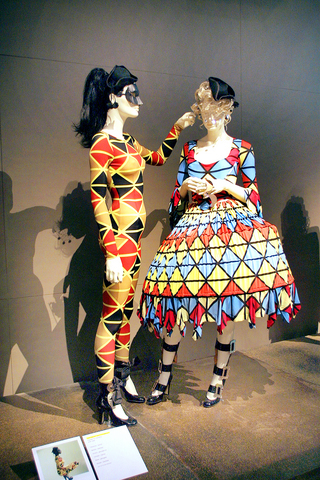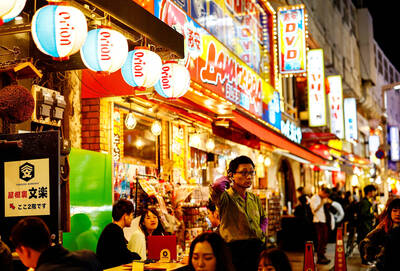1. Fashionable art
Winning hands down is the exhibition that surpassed attendance records and that is the retrospective of Vivienne Westwood's fashion designs. From the glitzy celebrity-studded opening to its weekend hours-long queues, this exhibition showed how to be both provocative and a blockbuster. Now, that's a hard act to follow.

PHOTO COURTESY OF TFAM
2. Give me the facts, ma'am and nothing but the facts
The Taipei Fine Arts Museum's press department is unequaled. TFAM provides journalists with timely information detailing the "who, what, where and when," which is mind-bogglingly absent in most press kits.
3. The global village
This summer's Taiwan Pavilion titled "The Spectre of Freedom" at the Venice Biennale was curated by Jason Wang Chia-chi (王嘉驥) and showed that Taiwan's artists can easily hold a candle to their international peers.
4. It's all in the details
The Lake: Towards a Cross-Cultural Dialogue, at the Taipei Artist Village, was organized by photographer Yeh Weili (葉偉立) showed that extremely well thought-out organization from start to finish pays off. Not only did the exhibition have a dynamic installation to showcase photos, to listen to experimental music and to read creative writing, it also opened with a night of poetry and music.
5. Community art
Public art that engages the local community and helps members feel proud of their neighborhoods was most notably seen in the second Taipei Public Art Festival of the Dihua Sewage Treatment Plant, and Tainan's Hai-an Road of painted building facades.
6. Digital art rules
Taichung's National Taiwan Museum of Fine Arts hosted an exhibition of Ars Electronica's award-winning digital works, organized by local curating team Unison 8 who put on a snazzy display. Additionally, this year the National Culture and Arts Foundation created its first Techno Art Creation Project that gives funding to artists to create digital projects.
7. Thinking outside the box
Taipei MOMA exhibited Taiwanese contemporary art not in the gallery, but at the Director General of the British Trade and Cultural Office's residence, thus bringing local art to a different audience.
8. Read a good book
This was an exceptional year for curator Jason Wang Chia-chi. Besides curating the show in Venice, his Variation Xanadu, on view at MOCA looked to Coleridge's Kubla Khan for inspiration and displayed hypnotic videos from a wide range of artists. Chen Chieh-jen (陳界仁) created a new film for this exhibition, while Jun Nguyen-Hatsushiba's underwater scenes and Hiraki Sawa's miniature scale jets created contemplative new worlds.
9. An earful of art
The B!AS International Sound Art Exhibition at TFAM curated by artists Wang Jun-Jieh (王俊傑) and Huang Wen-Hao (黃文浩) brought together 10 experimental sound artists, highlighted by Maywa Denki's (掇明和電機) wacky performance at Luxy nighclub.
10. Auld lang syne
And ending the year was a small, rueful exhibition by Lin Chuan-chu (林銓居), showing that traditional Chinese ink painting is still contemporary and that creating memoir-style art can still strike a deep chord within the viewer.

On April 26, The Lancet published a letter from two doctors at Taichung-based China Medical University Hospital (CMUH) warning that “Taiwan’s Health Care System is on the Brink of Collapse.” The authors said that “Years of policy inaction and mismanagement of resources have led to the National Health Insurance system operating under unsustainable conditions.” The pushback was immediate. Errors in the paper were quickly identified and publicized, to discredit the authors (the hospital apologized). CNA reported that CMUH said the letter described Taiwan in 2021 as having 62 nurses per 10,000 people, when the correct number was 78 nurses per 10,000

May 5 to May 11 What started out as friction between Taiwanese students at Taichung First High School and a Japanese head cook escalated dramatically over the first two weeks of May 1927. It began on April 30 when the cook’s wife knew that lotus starch used in that night’s dinner had rat feces in it, but failed to inform staff until the meal was already prepared. The students believed that her silence was intentional, and filed a complaint. The school’s Japanese administrators sided with the cook’s family, dismissing the students as troublemakers and clamping down on their freedoms — with

As Donald Trump’s executive order in March led to the shuttering of Voice of America (VOA) — the global broadcaster whose roots date back to the fight against Nazi propaganda — he quickly attracted support from figures not used to aligning themselves with any US administration. Trump had ordered the US Agency for Global Media, the federal agency that funds VOA and other groups promoting independent journalism overseas, to be “eliminated to the maximum extent consistent with applicable law.” The decision suddenly halted programming in 49 languages to more than 425 million people. In Moscow, Margarita Simonyan, the hardline editor-in-chief of the

Six weeks before I embarked on a research mission in Kyoto, I was sitting alone at a bar counter in Melbourne. Next to me, a woman was bragging loudly to a friend: She, too, was heading to Kyoto, I quickly discerned. Except her trip was in four months. And she’d just pulled an all-nighter booking restaurant reservations. As I snooped on the conversation, I broke out in a sweat, panicking because I’d yet to secure a single table. Then I remembered: Eating well in Japan is absolutely not something to lose sleep over. It’s true that the best-known institutions book up faster